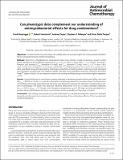Files in this item
Can phenotypic data complement our understanding of antimycobacterial effects for drug combinations?
Item metadata
| dc.contributor.author | Kloprogge, Frank | |
| dc.contributor.author | Hammond, Robert | |
| dc.contributor.author | Copas, Andrew | |
| dc.contributor.author | Gillespie, Stephen H | |
| dc.contributor.author | Della Pasqua, Oscar | |
| dc.date.accessioned | 2019-09-17T16:30:02Z | |
| dc.date.available | 2019-09-17T16:30:02Z | |
| dc.date.issued | 2019-12 | |
| dc.identifier | 261174331 | |
| dc.identifier | 1b5be49c-93e2-4614-8af3-6e2213928053 | |
| dc.identifier | 31504558 | |
| dc.identifier | 85075093232 | |
| dc.identifier | 000501732800017 | |
| dc.identifier.citation | Kloprogge , F , Hammond , R , Copas , A , Gillespie , S H & Della Pasqua , O 2019 , ' Can phenotypic data complement our understanding of antimycobacterial effects for drug combinations? ' , Journal of Antimicrobial Chemotherapy , vol. 74 , no. 12 , pp. 3530–3536 . https://doi.org/10.1093/jac/dkz369 | en |
| dc.identifier.issn | 0305-7453 | |
| dc.identifier.other | ORCID: /0000-0001-6537-7712/work/61622214 | |
| dc.identifier.other | ORCID: /0000-0003-3664-3641/work/157140948 | |
| dc.identifier.uri | https://hdl.handle.net/10023/18496 | |
| dc.description | Funding: British Society for Antimicrobial Chemotherapy Research Grant (GA2015-172R). F. K. conducted the research as part of a Medical Research Council fellowship (MR/P014534/1). | en |
| dc.description.abstract | Objectives : To demonstrate how phenotypic cell viability data can provide insight into antimycobacterial effects for the isoniazid/rifampicin treatment backbone. Methods : Data from a Mycobacterium komossense hollow-fibre infection model comprising a growth control group, rifampicin at three different exposures (Cmax = 0.14, 0.4 and 1.47 mg/L with t½ = 1.57 h and τ = 8 h) and rifampicin plus isoniazid (Cmax rifampicin = 0.4 mg/L and Cmax isoniazid = 1.2 mg/L with t½ = 1.57 h and τ = 8 h) were used for this investigation. A non-linear mixed-effects modelling approach was used to fit conventional cfu data, quantified using solid-agar plating. Phenotypic proportions of respiring (alive), respiring but with damaged cell membrane (injured) and 'not respiring' (dead) cells data were quantified using flow cytometry and Sytox Green™ (Sigma-Aldrich, UK) and resazurin sodium salt staining and fitted using a multinomial logistic regression model. Results : Isoniazid/rifampicin combination therapy displayed a decreasing overall antimicrobial effect with time (θTime1/2 = 438 h) on cfu data, in contrast to rifampicin monotherapy where this trend was absent. In the presence of isoniazid a phenotype associated with cell injury was displayed, whereas with rifampicin monotherapy a pattern of phenotypic cell death was observed. Bacterial killing onset time on cfu data correlated negatively (θTime50 = 28.9 h, θLAGRIF50 = 0.132 mg/L) with rifampicin concentration up to 0.165 mg/L and this coincided with a positive relationship between rifampicin concentration and the probability of phenotypic cell death. Conclusions : Cell viability data provide structured information on the pharmacodynamic interaction between isoniazid and rifampicin that complements the understanding of the antibacillary effects of this mycobacterial treatment backbone. | |
| dc.format.extent | 7 | |
| dc.format.extent | 668522 | |
| dc.language.iso | eng | |
| dc.relation.ispartof | Journal of Antimicrobial Chemotherapy | en |
| dc.subject | QR Microbiology | en |
| dc.subject | RM Therapeutics. Pharmacology | en |
| dc.subject | NDAS | en |
| dc.subject.lcc | QR | en |
| dc.subject.lcc | RM | en |
| dc.title | Can phenotypic data complement our understanding of antimycobacterial effects for drug combinations? | en |
| dc.type | Journal article | en |
| dc.contributor.institution | University of St Andrews. Infection and Global Health Division | en |
| dc.contributor.institution | University of St Andrews. School of Medicine | en |
| dc.contributor.institution | University of St Andrews. Sir James Mackenzie Institute for Early Diagnosis | en |
| dc.contributor.institution | University of St Andrews. Centre for Biophotonics | en |
| dc.contributor.institution | University of St Andrews. Biomedical Sciences Research Complex | en |
| dc.contributor.institution | University of St Andrews. Global Health Implementation Group | en |
| dc.contributor.institution | University of St Andrews. Gillespie Group | en |
| dc.contributor.institution | University of St Andrews. Infection Group | en |
| dc.identifier.doi | 10.1093/jac/dkz369 | |
| dc.description.status | Peer reviewed | en |
This item appears in the following Collection(s)
Items in the St Andrews Research Repository are protected by copyright, with all rights reserved, unless otherwise indicated.

